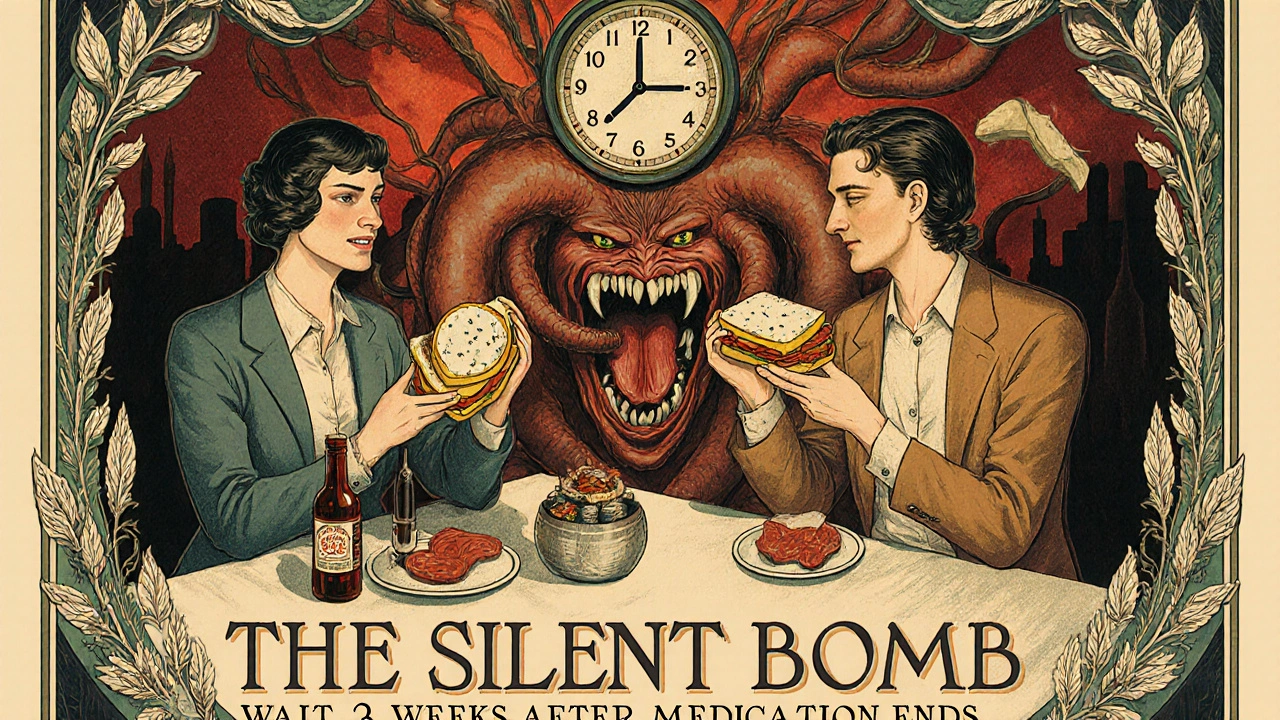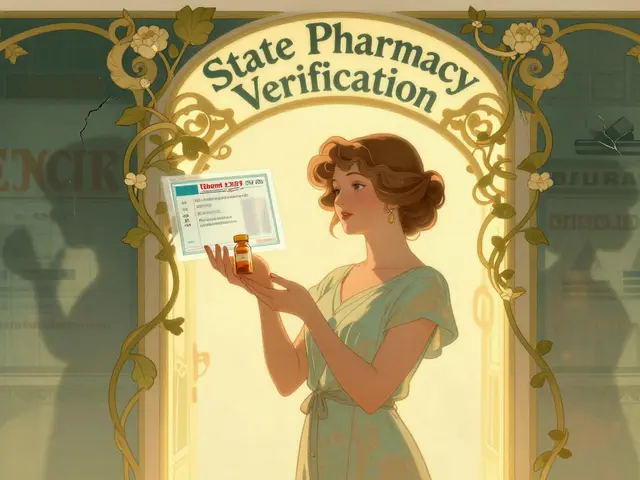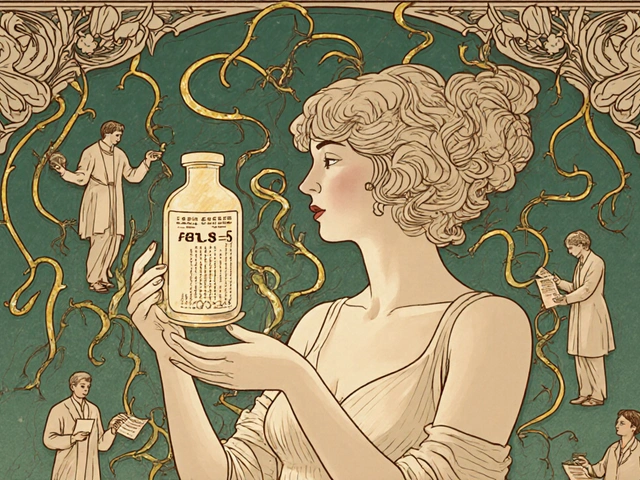MAOI Tyramine Risk Calculator
This calculator helps determine safe tyramine intake while taking MAOI drugs. The maximum recommended daily intake is 600 mcg of tyramine. Select foods and quantities to calculate your total intake.
Selected Foods:
Results
When you're on certain antidepressants or Parkinson’s medications, your favorite cheese plate or deli sandwich could trigger a medical emergency. It’s not about food safety or spoilage - it’s about a silent, powerful chemical reaction between what you eat and the medicine you take. The culprit? tyramine, a compound found in aged cheeses and processed meats that can spike your blood pressure to life-threatening levels if you’re taking MAOI drugs.
What Are MAOI Drugs and Why Do They Matter?
MAOI stands for monoamine oxidase inhibitor. These are prescription medications used for treatment-resistant depression, panic disorder, and sometimes Parkinson’s disease. Common brands include Nardil (phenelzine) and Parnate (tranylcypromine). They work by blocking an enzyme called monoamine oxidase, which normally breaks down excess neurotransmitters like serotonin, dopamine, and norepinephrine in your body. That’s helpful for mood regulation - but it also means your body can’t break down tyramine anymore. Tyramine is a natural substance formed when proteins in food break down over time. Normally, your gut and liver handle it easily. But when MAOIs shut down that cleanup system, tyramine builds up and forces your nerves to dump huge amounts of norepinephrine - a stress hormone that tightens blood vessels and rockets your blood pressure upward. In minutes, systolic pressure can jump from 120 to over 180 mmHg. That’s a hypertensive crisis. Symptoms include blinding headaches, chest pain, rapid heartbeat, sweating, blurred vision, and sometimes stroke or heart attack.Which Cheeses Are Dangerous?
Not all cheeses are created equal. Fresh cheeses made from pasteurized milk and eaten soon after production have almost no tyramine. But once cheese ages, ferments, or ripens, tyramine levels climb - sometimes dangerously high.- High-risk cheeses: Aged cheddar (72-953 mcg/g), Parmesan (610-1,400 mcg/g), Swiss (400-1,200 mcg/g), blue cheeses like Gorgonzola and Stilton (1,000-3,500 mcg/g), and brined feta (350-800 mcg/g).
- Moderate-risk cheeses: Camembert, Brie (200-600 mcg/g), Gruyère, Edam (150-500 mcg/g).
- Safe cheeses: Cottage cheese (<30 mcg/g), ricotta (<40 mcg/g), fresh mozzarella (<25 mcg/g), cream cheese (<20 mcg/g), American cheese (<50 mcg/g).
A single 30-gram serving of aged cheddar can contain up to 28.59 mg of tyramine. The threshold for triggering a crisis? As low as 6 mg for sensitive people. For others, it might take 10-25 mg. That means one slice of Parmesan on your pasta could be enough.
Processed Meats Are Just as Risky
Cured, smoked, fermented, or dry-aged meats are tyramine powerhouses. The longer they sit, the more tyramine builds up. Here’s what to avoid:- High-risk meats: Dry summer sausages (300-900 mcg/g), pepperoni (200-600 mcg/g), salami (150-500 mcg/g).
- Moderate-risk meats: Bacon (75-250 mcg/g), corned beef (60-180 mcg/g), bologna (50-200 mcg/g).
- Safe meats: Freshly cooked chicken, beef, pork, turkey - as long as they’re not cured or aged.
Even a deli sandwich with pepperoni or salami can push you over the edge. Many people don’t realize that packaged lunch meats aren’t just “pre-sliced” - they’re often fermented and aged for flavor and preservation. Always check labels for terms like “dry-cured,” “fermented,” or “air-dried.”
Other Hidden Sources of Tyramine
Cheese and meat aren’t the only risks. Tyramine hides in unexpected places:- Soy sauce: 1,000-2,500 mcg/g - a tablespoon can have more than 10 mg.
- Miso paste: 800-2,000 mcg/g - common in soups and marinades.
- Fish sauce: 1,200-3,000 mcg/g - used in Thai and Vietnamese dishes.
- Fermented tofu, draft beer, and overripe bananas also contain measurable amounts.
But not everything on the “avoid” list is dangerous. Bananas themselves are low-risk (under 10 mcg/g). Chocolate? Only 50-150 mcg/g - a small piece is usually fine. Peanuts? Around 75-200 mcg/g - not a problem unless you’re eating a whole bag. The key is portion and frequency. One serving of a high-tyramine food might be okay. Two servings, or combining them, can be deadly.

Real Stories, Real Consequences
People don’t always know they’re at risk until it’s too late. On online forums, users share harrowing experiences:One person on Drugs.com ate a salad with Parmesan while on Nardil. Within 20 minutes, their blood pressure hit 198/112. They ended up in the ER with a splitting headache and shaking hands. Another user on Reddit, who’d been on MAOIs for five years, learned through trial and error that just 15 grams of aged cheddar - about a teaspoon-sized piece - was their personal limit. Anything more triggered a pounding headache and racing pulse.
According to GoodRx’s database of 1,247 user reports, 68% of MAOI-related emergencies involved cheese. Another 22% involved processed meats. Symptoms? 92% reported severe headaches, 76% had palpitations, and 68% broke into cold sweats - all within 15 to 30 minutes of eating.
How Long Do the Risks Last?
This isn’t just a problem while you’re taking the medication. The enzyme monoamine oxidase doesn’t bounce back overnight. Even after you stop your MAOI, you need to avoid high-tyramine foods for two to three weeks. Otherwise, your body still can’t process tyramine properly, and the danger remains.That’s why many patients accidentally slip up - they think once they stop the pill, they’re safe. They’re not. A single bite of blue cheese weeks after quitting Parnate can still trigger a crisis.
What Can You Eat Instead?
You don’t have to give up flavor - just change how you get it.- Swap aged cheddar for fresh mozzarella or cream cheese.
- Use grilled chicken or turkey instead of salami or pepperoni in sandwiches.
- Choose fresh herbs, lemon juice, or vinegar for flavor instead of soy sauce or fish sauce.
- Buy “MAOI-safe” cheese lines - some brands like Sargento now sell refrigerated fresh mozzarella cups labeled for medication users.
Many restaurants now offer “MAOI-friendly” menu options. Ask if cheeses are fresh or aged. Request no cured meats. Bring your own dressing. It’s not about deprivation - it’s about smart substitutions.

How to Stay Safe Every Day
Managing this interaction isn’t guesswork. It’s a system:- Read labels. Look for “aged,” “fermented,” “dry-cured,” or “ripened.” Avoid anything that sounds like it’s been sitting around.
- Track your food. Keep a simple diary: what you ate, when, and how you felt. Note any spikes in blood pressure.
- Check your BP. Use a home monitor twice daily. If your systolic pressure jumps more than 30 points above your normal, stop eating and call your doctor.
- Carry an emergency card. It should say: “I’m on an MAOI. Avoid tyramine-rich foods. If I collapse, call 911.”
- Consult a dietitian. A professional can help you map out safe meals in under three weeks - far faster than trial and error.
Many patients struggle with social situations - birthday parties, holidays, restaurant dinners. That’s normal. But with preparation, you can still enjoy meals. Bring your own dish. Eat beforehand. Ask questions politely. Most people are willing to help once they understand the stakes.
What’s Changing in 2025?
The medical world is catching up. In 2023, the Mayo Clinic launched a phone app called “MAOI Diet Tracker” that scans barcodes to flag high-tyramine foods. Beta testers got it right 89% of the time. The American Heart Association updated its guidelines in April 2023, raising the safe tyramine threshold from 5 mg to 6 mg per serving - a small but meaningful shift based on new research.Future solutions are even more promising. The NIH is testing a supplement that helps break down tyramine before it enters your bloodstream. Early results look good. By 2025, food manufacturers may start voluntarily labeling tyramine content on cheese packages. And researchers are even exploring genetically modified cheeses with naturally low tyramine levels - designed specifically for people on MAOIs.
But for now, the safest tool you have is knowledge. And discipline.
Why This Matters More Than You Think
About 1.4 million Americans take MAOIs every year. That’s not a small group. And yet, dietary non-compliance causes 61% of all MAOI-related emergency visits, according to the CDC. Most of those cases are preventable. People aren’t being careless - they’re misinformed. They think “aged cheese” just means “strong flavor.” They don’t realize it’s a chemical bomb.This isn’t about fear. It’s about awareness. You can live fully on MAOIs. You can eat well, socialize, travel. But you need to know what’s safe - and what’s not. One bite can change everything. So learn. Track. Ask. And never assume.
Can I eat blue cheese if I’m on an MAOI?
No. Blue cheeses like Gorgonzola, Stilton, and Roquefort contain 1,000-3,500 mcg of tyramine per gram - among the highest levels of any food. Even a small piece can trigger a dangerous blood pressure spike. Avoid them completely while on MAOIs and for at least two weeks after stopping.
Is feta cheese safe on MAOIs?
Feta cheese preserved in brine contains 350-800 mcg/g of tyramine, making it high-risk. It’s not safe to eat regularly. If you must have it, limit to a single small serving (under 15g) and monitor your blood pressure closely. Fresh mozzarella is a much safer alternative.
How long after stopping MAOIs can I eat aged cheese again?
You must wait two to three weeks after your last dose. Monoamine oxidase enzyme activity takes 14-21 days to fully recover. Eating high-tyramine foods too soon can still cause a hypertensive crisis, even if you’re no longer taking the medication.
Do all processed meats contain tyramine?
No. Only cured, fermented, or dry-aged meats like salami, pepperoni, and summer sausage have high levels. Freshly cooked meats - like grilled chicken, turkey, or pork - contain less than 10 mcg/g and are safe. Always check how the meat was prepared. If it says “dry-cured” or “air-dried,” avoid it.
Can I drink beer while on MAOIs?
Draft or tap beer can contain tyramine due to fermentation. Bottled or canned beer is usually lower risk but still not recommended. The safest choice is to avoid all alcohol while on MAOIs. If you do drink, limit to one small serving and monitor for symptoms like headache or palpitations.
What should I do if I accidentally eat aged cheese or salami?
Check your blood pressure immediately. If your systolic reading is above 160 mmHg or you feel a severe headache, pounding heart, chest pain, or blurred vision, call 911 or go to the ER. Do not wait. Tyramine reactions can escalate within minutes. Keep your emergency card handy and tell medical staff you’re on an MAOI.







Nonie Rebollido
November 27, 2025 AT 20:39Thanks for this, I’m swapping out my cheese board for cream cheese now.
Agha Nugraha
November 28, 2025 AT 13:40Andy Smith
November 29, 2025 AT 08:50Rekha Tiwari
November 30, 2025 AT 13:08Thank you for sharing this-I’m telling my whole family now! ❤️
Leah Beazy
November 30, 2025 AT 17:08John Villamayor
December 2, 2025 AT 14:17weird how food changes with time
Jenna Hobbs
December 2, 2025 AT 19:52Ophelia Q
December 3, 2025 AT 15:43Elliott Jackson
December 5, 2025 AT 03:57McKayla Carda
December 6, 2025 AT 12:50Andy Smith
December 7, 2025 AT 07:18